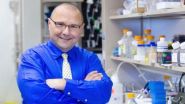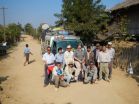(Press-News.org) When active, the protein called Ral can drive tumor growth and metastasis in several human cancers including pancreatic, prostate, lung, colon and bladder. Unfortunately, drugs that block its activity are not available. A study published today in the journal Nature uses a novel approach to target the activation of these Ral proteins: "When you want to keep an alligator from biting you, you can tie its mouth shut. We took another approach – we put a stick in its mouth to hold it open," says Dan Theodorescu, MD, PhD, professor of Urology and Pharmacology, director of the University of Colorado Cancer Center and the study's senior author, who led a multidisciplinary team of investigators from the University of Colorado, Indiana University, the University of Virginia and Yale University.
The study used sophisticated computer models to examine the structure of the Ral protein in its "inactive" form, looking specifically for changes in this structure as the protein became "active". It turned out that "inactive" Ral has a cavity that disappears when the protein becomes active. This was the "mouth" and now Theodorescu and colleagues needed the "stick".
The search for the stick required using a computer to dock 500,000 compounds in this cavity, which resulted in 88 candidate small molecules that might bind to inactive Ral and prevent its activation. The researchers took the findings to human cancer cells, treating these with the compounds to see which resulted in the greatest reduction of Ral activation. A handful of compounds emerged from the group as especially able to reduce Ral activation in lung cancer cells.
Further testing evaluated the compounds' abilities to slow the growth of human cancer cells in suspension – a proxy for metastasis. One molecule, RBC8 proved most successful in this regard. To further refine the working molecule, the team synthesized derivatives of RBC8 and compared these derivatives to the parent molecule, finding that a compound they labeled BQU57 was quite effective.
Next, tests moved to human lung cancer cell models in mice, with the major question being whether cells in an animal model would take up BQU57 in a way that allowed the compound to eventually be a potential drug in cancer patients. In other words, would what worked in a dish also work in an animal?
Sure enough, hours after dosing, BQU57 had entered tumor tissue. Not only had it entered tumor tissue, but the drug slowed the growth of these tumors. Analysis showed that BQU57 had stopped the activation of Ral in treated tumors.
"We still need to optimize these compounds and then characterize these agents for toxicity in several animal species and determine their optimal route of delivery, such as oral or intravenous before moving to the clinic," Theodorescu says. "But we see this work as a valuable first step in the development of a novel class of therapeutic agents directed at Ral. The concept of targeting sites on proteins that collapse upon activation, and whose collapse is required for activation, could in principle be used to discover drugs aimed at other proteins driving human disease as well."
INFORMATION:
About the University of Colorado Cancer Center
Located on the Anschutz Medical Campus, the University of Colorado Cancer Center is Colorado's only National Cancer Institute-designated comprehensive cancer center, a distinction recognizing its outstanding contributions to research, clinical trials, prevention and cancer control. CU Cancer Center is a member of the prestigious National Comprehensive Cancer Network®, an alliance of the nation's leading cancer centers working to establish and deliver guidelines for clinical cancer practice. Our primary clinical care partner, the University of Colorado Hospital, was recently ranked #15 for cancer care by U.S. News & World Report. CU Cancer Center is comprised of more than 350 researchers and physicians at three state universities and other institutions, all working toward one goal: Translating cancer science into life. For more information visit Coloradocancercenter.org and follow CU Cancer Center on Facebook and Twitter.
Nature: New drug blocks gene driving cancer growth
'When you want to keep an alligator from biting you, you can tie its mouth shut. We took another approach: We put a stick in its mouth to hold it open.'
2014-09-15
ELSE PRESS RELEASES FROM THIS DATE:
Blood-cleansing biospleen device developed for sepsis therapy
2014-09-15
Things can go downhill fast when a patient has sepsis, a life-threatening condition in which bacteria or fungi multiply in a patient's blood -- often too fast for antibiotics to help. A new device inspired by the human spleen and developed by a team at Harvard's Wyss Institute for Biologically Inspired Engineering may radically transform the way doctors treat sepsis.
"Even with the best current treatments, sepsis patients are dying in intensive care units at least 30 percent of the time," said Mike Super, Ph.D., Senior Staff Scientist at the Wyss Institute. "We need ...
Muscular dystrophy: Repair the muscles, not the genetic defect
2014-09-15
ANN ARBOR, Mich.---A potential way to treat muscular dystrophy directly targets muscle repair instead of the underlying genetic defect that usually leads to the disease.
Muscular dystrophies are a group of muscle diseases characterized by skeletal muscle wasting and weakness. Mutations in certain proteins, most commonly the protein dystrophin, cause muscular dystrophy in humans and also in mice.
A University of Michigan team led by cell biologist Haoxing Xu, discovered that mice missing a critical calcium channel inside the cell, called TRPML1, showed similar muscle ...
Three's a charm: NIST detectors reveal entangled photon triplets
2014-09-15
BOULDER, Colo – Researchers at the University of Waterloo in Canada have directly entangled three photons in the most technologically useful state for the first time, thanks in part to superfast, super-efficient single-photon detectors developed by the National Institute of Standards and Technology (NIST).
Entanglement is a special feature of the quantum world in which certain properties of individual particles become linked such that knowledge of the quantum state of any one particle dictates that of the others. Entanglement plays a critical role in quantum information ...
The Lancet: Some lung cancer patients could live longer when treated
2014-09-15
Treating advanced small-cell lung cancer (SCLC) with thoracic (or chest) radiation therapy in addition to standard treatment significantly prolongs long-term survival and reduces cancer recurrence in the chest by almost 50%, according to new research published in The Lancet and being presented simultaneously at ASTRO's 2014 Annual Meeting in San Francisco.
The authors say that as the thoracic radiotherapy is well tolerated, it should to be routinely offered to all SCLC patients with extensive disease whose cancer responds to chemotherapy.
SCLC is an aggressive cancer ...
Researchers find neural compensation in people with Alzheimer's-related protein
2014-09-15
Berkeley — The human brain is capable of a neural workaround that compensates for the buildup of beta-amyloid, a destructive protein associated with Alzheimer's disease, according to a new study led by researchers at the University of California, Berkeley.
The findings, to be published Sunday, Sept. 14, in the journal Nature Neuroscience, could help explain how some older adults with beta-amyloid deposits in their brain retain normal cognitive function while others develop dementia.
"This study provides evidence that there is plasticity or compensation ability in ...
Asian monsoon much older than previously thought
2014-09-15
The Asian monsoon already existed 40 million years ago during a period of high atmospheric carbon dioxide and warmer temperatures, reports an international research team led by a University of Arizona geoscientist.
Scientists thought the climate pattern known as the Asian monsoon began 22-25 million years ago as a result of the uplift of the Tibetan Plateau and the Himalaya Mountains.
"It is surprising," said lead author Alexis Licht, now a research associate in the UA department of geosciences. "People thought the monsoon started much later."
The monsoon, the largest ...
University of Leeds press release: One care lapse can be fatal for heart attack patients
2014-09-15
University of Leeds research has revealed that heart attack patients have a 46% increased chance of death within a month of discharge if they miss any one of nine types of care.
There is also a 74% increased chance of dying within one year if any one component of care is missed.
The nine pathways of care that have been identified are pre-hospital electrocardiogram, acute use of aspirin, restoring blood flow to the heart (known as reperfusion), prescription at hospital discharge of aspirin, timely use of four types of drug for heart attack (ACE-inhibitors, beta-blockers, ...
New insights in survival strategies of bacteria
2014-09-15
Bacteria are particularly ingenious when it comes to survival strategies. They often create a biofilm to protect themselves from a hostile environment, for example during treatment with antibiotics. A biofilm is a bacterial community that is surrounded by a protective slime capsule consisting of sugar chains and "curli". Scientists at VIB and Vrije Universiteit Brussel have for the first time created a detailed three-dimensional image of the pores through which the curli building blocks cross the bacterial cell wall, a crucial step in the formation of the protective slime ...
How an ancient vertebrate uses familiar tools to build a strange-looking head
2014-09-15
Kansas City, Mo. - If you never understood what "ontogeny recapitulates phylogeny" meant in high school, don't worry: biologists no longer think that an animal's "ontogeny", that is, its embryonic development, replays its entire evolutionary history. Instead, the new way to figure out how animals evolved is to compare regulatory networks that control gene expression patterns, particularly embryonic ones, across species. An elegant study published in the September 14, 2014 advance online issue of Nature from the Stowers Institute for Medical Research shows just how humbling ...
Breast screening for over 70s doesn't prompt sharp fall in advanced disease
2014-09-15
Instead, it may just lead to overdiagnosis and overtreatment, suggest the researchers, led by a team based at Leiden University Medical Centre in the Netherlands.
Their paper publishes as the Preventing Overdiagnosis conference opens next week (Monday 15 Sept), where experts from around the world will discuss how to tackle the threat to health and the waste of money caused by unnecessary care. The conference is hosted by the Centre for Evidence-Based Medicine at the University of Oxford in partnership with The BMJ's Too Much Medicine campaign.
The upper age limit for ...
LAST 30 PRESS RELEASES:
Structure of dopamine-releasing neurons relates to the type of circuits they form for smell-processing
Reducing social isolation protects the brain in later life
Keeping the heart healthy increases longevity even after cancer
Young adults commonly mix cannabis with nicotine and tobacco
Comprehensive review illuminates tau protein's dual nature in brain health, disease, and emerging psychiatric connections
Book prepares K-12 leaders for the next public health crisis
Storms in the Southern Ocean mitigates global warming
Seals on the move: Research reveals key data for offshore development and international ecology
Sports injuries sustained during your period might be more severe
World's first successful 2 Tbit/s free-space optical communication using small optical terminals mountable on satellites and HAPS
Can intimate relationships affect your heart? New study says ‘yes’
Scalable and healable gradient textiles for multi‑scenario radiative cooling via bicomponent blow spinning
Research shows informed traders never let a good climate crisis go to waste
Intelligent XGBoost framework enhances asphalt pavement skid resistance assessment
Dual-function biomaterials for postoperative osteosarcoma: Tumor suppression and bone regeneration
New framework reveals where transport emissions concentrate in Singapore
NTP-enhanced lattice oxygen activation in Ce-Co catalysts for low-temperature soot combustion
Synergistic interface engineering in Cu-Zn-Ce catalysts for efficient CO2 hydrogenation to methanol
COVID-19 leaves a lasting mark on the human brain
Scientists use ultrasound to soften and treat cancer tumors without damaging healthy tissue
Community swimming program for Black youth boosts skills, sense of belonging, study finds
Specific depressive symptoms in midlife linked to increased dementia risk
An ‘illuminating’ design sheds light on cholesterol
Who is more likely to get long COVID?
Study showcases resilience and rapid growth of “living rocks”
Naval Research Lab diver earns Office of Naval Research 2025 Sailor of the Year
New Mayo-led study establishes practical definition for rapidly progressive dementia
Fossil fuel industry’s “climate false solutions” reinforce its power and aggravate environmental injustice
Researchers reveal bias in a widely used measure of algorithm performance
Alcohol causes cancer. A study from IOCB Prague confirms damage to DNA and shows how cells defend against it
[Press-News.org] Nature: New drug blocks gene driving cancer growth'When you want to keep an alligator from biting you, you can tie its mouth shut. We took another approach: We put a stick in its mouth to hold it open.'





